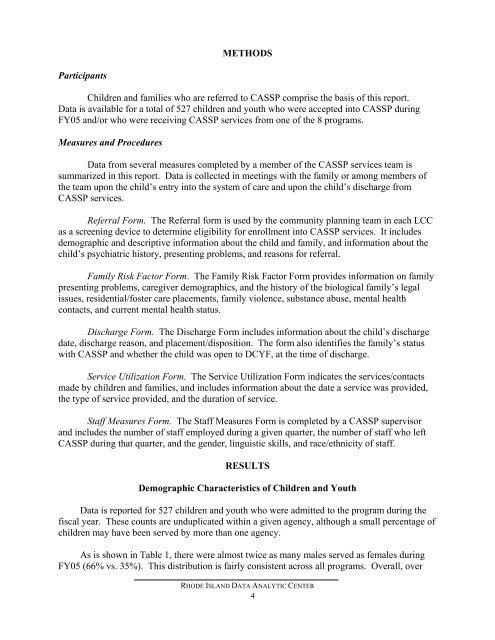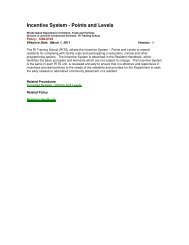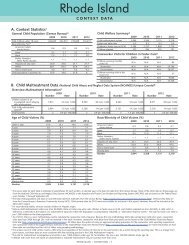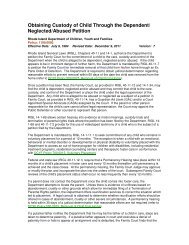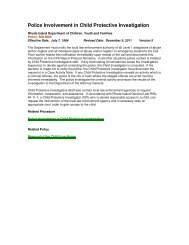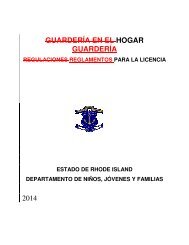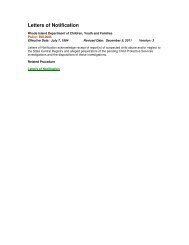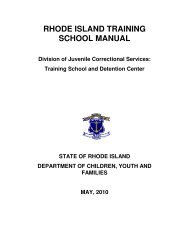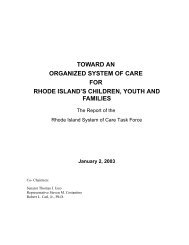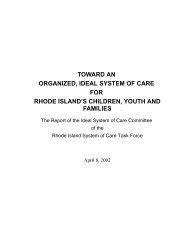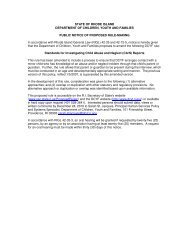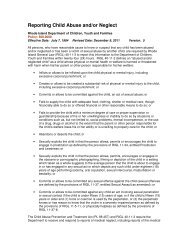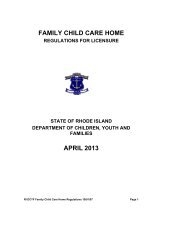(CASSP) Report Part 1 - RI Department of Children, Youth & Families
(CASSP) Report Part 1 - RI Department of Children, Youth & Families
(CASSP) Report Part 1 - RI Department of Children, Youth & Families
Create successful ePaper yourself
Turn your PDF publications into a flip-book with our unique Google optimized e-Paper software.
METHODS<strong>Part</strong>icipants<strong>Children</strong> and families who are referred to <strong>CASSP</strong> comprise the basis <strong>of</strong> this report.Data is available for a total <strong>of</strong> 527 children and youth who were accepted into <strong>CASSP</strong> duringFY05 and/or who were receiving <strong>CASSP</strong> services from one <strong>of</strong> the 8 programs.Measures and ProceduresData from several measures completed by a member <strong>of</strong> the <strong>CASSP</strong> services team issummarized in this report. Data is collected in meetings with the family or among members <strong>of</strong>the team upon the child’s entry into the system <strong>of</strong> care and upon the child’s discharge from<strong>CASSP</strong> services.Referral Form. The Referral form is used by the community planning team in each LCCas a screening device to determine eligibility for enrollment into <strong>CASSP</strong> services. It includesdemographic and descriptive information about the child and family, and information about thechild’s psychiatric history, presenting problems, and reasons for referral.Family Risk Factor Form. The Family Risk Factor Form provides information on familypresenting problems, caregiver demographics, and the history <strong>of</strong> the biological family’s legalissues, residential/foster care placements, family violence, substance abuse, mental healthcontacts, and current mental health status.Discharge Form. The Discharge Form includes information about the child’s dischargedate, discharge reason, and placement/disposition. The form also identifies the family’s statuswith <strong>CASSP</strong> and whether the child was open to DCYF, at the time <strong>of</strong> discharge.Service Utilization Form. The Service Utilization Form indicates the services/contactsmade by children and families, and includes information about the date a service was provided,the type <strong>of</strong> service provided, and the duration <strong>of</strong> service.Staff Measures Form. The Staff Measures Form is completed by a <strong>CASSP</strong> supervisorand includes the number <strong>of</strong> staff employed during a given quarter, the number <strong>of</strong> staff who left<strong>CASSP</strong> during that quarter, and the gender, linguistic skills, and race/ethnicity <strong>of</strong> staff.RESULTSDemographic Characteristics <strong>of</strong> <strong>Children</strong> and <strong>Youth</strong>Data is reported for 527 children and youth who were admitted to the program during thefiscal year. These counts are unduplicated within a given agency, although a small percentage <strong>of</strong>children may have been served by more than one agency.As is shown in Table 1, there were almost twice as many males served as females duringFY05 (66% vs. 35%). This distribution is fairly consistent across all programs. Overall, overRHODE ISLAND DATA ANALYTIC CENTER4


